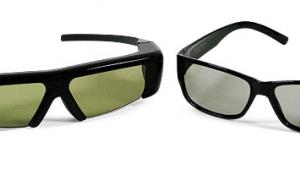Glasses—3D's Achilles' Heel

Aye, there's the rubto see anything in 3D on that new TV, you must wear special glasses. In all the hoopla about 3D, this inconvenient truth is often glossed over, yet it's one of the biggest pitfalls in the entire 3D infrastructure.
Virtually all 3DTVs now coming to market use active-shutter glasses, in which the left and right lenses alternately open and close in sync with the TV, which displays the left-eye image when the left lens is open and the right-eye image when the right lens is open. By contrast, most commercial 3D theaters use passive glassesthe right and left images are projected simultaneously, and the glasses filter the light so that only the left image reaches the left eye and only the right image reaches the right eye.
Aside from consumers' disdain for having to wear glasses at all, there are a few other drawbacks that could seriously impede the adoption of 3D in the home. First, there's the expenseactive-shutter glasses cost $100 to $150 per pair! In some cases, one or two pairs might be included with a new 3DTV, but what if you have a family of three, four, or more? What if you want to host a Super Bowl party? Are you going to spend hundreds of dollars for extra glasses after dropping several thousand on the TV?
Passive glasses are much less expensive, which is why they are used in public settings, but they have other drawbacks in the home. For example, with direct-view TVs such as LCD and plasma, using passive glasses cuts the horizontal or vertical resolution available for each eye in half. Can a resolution of 1920x540 or 960x1080 rightly be called high def?
Another problem with 3D glasses of all types is that they dramatically reduce the amount of light reaching your eyes. As it turns out, active-shutter glasses lose much more light than passive glasses because both lenses in active glasses must be closed during part of each cycle to prevent crosstalk (the left image getting into the right eye and vice versa). As a result, the display must pump out much more light than it does in 2D, which could shorten its life, especially plasmas. Even so, the perceived image is much dimmer than watching 2D.
Then there's the issue of cross-compatibility between manufacturersor, more specifically, the lack thereof. That's right, the glasses for a Panasonic 3DTV won't work with a Samsung model and vice versa. Why? The TV emits an infrared signal that the glasses use to synchronize with the alternating images. You might think that the manufacturers would have agreed on a standardized IR signal to perform this function, but noeach company uses its own proprietary signal. How stupid is that? Really stupid if you ask me.
A company called XpanD is trying to address this issue with its X103 "universal" active-shutter glasses (shown above), which are scheduled to be available in June. The glasses will contain a database of different manufacturers' IR sync signals, sort of like universal remotes with a database of different manufacturers' remote IR codes.
Will the issues I've presented here slow the infiltration of 3D into the home? Perhaps not in the initial stages, when early adopters eagerly acquire anything new. But mainstream consumers might not want to don glasses just to watch TV, not to mention having to shell out hundreds of dollars on extra pairs for the whole family. (Of course, you can watch regular 2D content without glasses, but then why get a 3DTV?) And forget about taking your Sony glasses to a friend's house to watch their Toshiba 3DTVthey probably won't work.
What's your take on the whole glasses angle? Will the requirement to wear them dissuade you from buying into 3D? Perhaps you object to the high cost, dim image, or cross-manufacturer incompatibility. Or maybe none of this matters and you can't wait to jump into the third dimension. In any event, I look forward to reading your comments here.












































